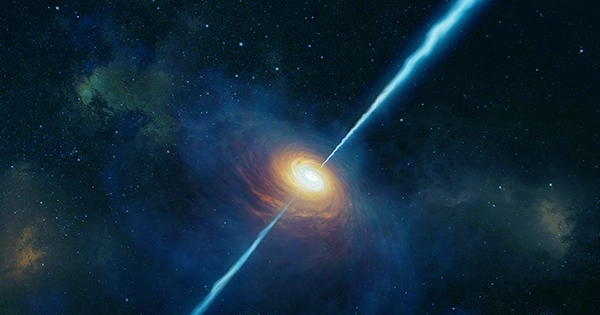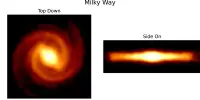Astronomers delved into the busy heart of a distant galaxy to study a supermassive black hole’s feeding habits and discovered that it recycles material. These findings may aid in our understanding of how supermassive black holes form.
Supermassive black holes with masses millions or billions of times that of the sun occur at the centers of most if not all, galaxies. In other situations, these black holes are surrounded by the matter they consume in the shape of plate-like disks known as accretion disks, which scientists believe allow them to develop. The central black hole’s gravitational force whips the accretion disk materials around at extraordinary speeds, generating enormous tidal forces in the gas and dust. This matter burns so brightly as it is churned that it can often eclipse the combined light of every star in the galaxy around it. Active galactic nuclei (AGNs) are brilliant center galactic regions.

A multinational team of scientists used the Atacama Large Millimeter/Subsillimeter Array (ALMA) to observe the AGN of the Circinus Galaxy, which is located roughly 13 million light-years away from Earth. This showed the intricate dance of gas around the feeding supermassive black hole at the heart of the AGN, and the team was able to see the black hole’s true feeding process.
It looked like the disk’s gravitational instability was forcing material toward the black hole. They also discovered that the black hole in question eats just about 3% of the matter that flows toward it. The rest appears to be pushed away by the AGN’s radiation, yet those material outflows appear to eventually collapse back into the supermassive black hole. It resembled a recycling process, akin to a water fountain on Earth.
“Detecting accretion flows and outflows in a region just a few light-years around the actively growing supermassive black hole, particularly in a multiphase gas, and even deciphering the accretion mechanism itself, are indeed monumental achievements in the history of supermassive black hole research,” Takuma Izumi, research leader and assistant professor at the National Astronomical Observatory of Japan (NAOJ), said in a statement.
Gas accretion methods have previously been explored at scales ranging from complete galaxies (about 100,000 light-years in width) to individual AGNs (a few hundred light-years in width). However, the dynamics of gas accretion in an AGN on the scale of a few dozen light-years remained unsolved until.
That was a problem since understanding how black holes evolve requires measuring how much gas goes into them and how much they push away. It is also necessary to understand the form that this gas takes, that is, how much of it is a superheated plasma of separated electrons and protons. How much does a gas of whole atoms cost? How much does cold molecular gas cost?
Understanding all of this requires looking at an AGN at very small sizes and accounting for the intricate motions of the streaming material. Using ALMA’s high-resolution power, this team was able to perform this with the AGN of the Circinus Galaxy. In essence, the researchers distinguished foreground molecular gas, which absorbs light from the brightly glowing background AGN. The team was able to catch the accretion flow into the AGN because the light-absorbing material is constantly flowing away from Earth.
The researchers also discovered gravitational instability as a feeding mechanism for the supermassive black hole. According to the researchers, this occurred because the accretion disk was subjected to a gravitational force so strong that its own speed couldn’t compensate. This indicates that the gas disk collapses under its own weight and is unable to maintain steady motion in the AGN. This not only creates complex structures within the disk, but it also accelerates gas toward the center supermassive black hole.
One important result of this research is the measurement of how much matter this supermassive black hole is actually devouring, which the team was able to see by measuring the density of the gas and the pace at which it was flowing to the AGN.
This demonstrated that the volume of gas moving toward the black hole was around 30 times greater than what was required to sustain the AGN’s activity. That means that the majority of the matter streaming into the black hole isn’t actually contributing to its expansion.
ALMA observed surplus matter being emitted as outflows, albeit at too slow a rate to escape the supermassive black hole completely. As a result, the emitted matter is drawn back to the accretion disk and finally recycled back into the black hole.
To confirm that this recycling mechanism is typical in AGNs, the team plans to examine other supermassive black holes using ALMA and future telescopes.
“To comprehensively understand the growth of supermassive black holes in cosmic history, we need to investigate various types of supermassive black holes located farther away,” Izumi said in his report. “This requires high-resolution and high-sensitivity observations, and we have high expectations for the further use of ALMA and for upcoming large radio interferometers in the next generation.”
















